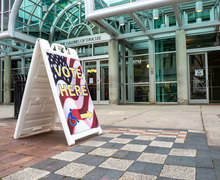Niles: We already know ride-hailing is great for your wallet. Here’s why it’s great for the environment.
Emmy Gnat | Head Illustrator
Ride-hailing companies such as Uber and Lyft have made it obvious that the future of their companies do not involve oil.
New York state’s recent law allowing ride-hailing services like Uber and Lyft to operate outside New York City has rightfully garnered a substantial amount of buzz. But New Yorkers don’t seem to realize how beneficial these services are to an environment currently polluted by traditional taxi usage.
Before the law was passed, upstate New York was one of the last remaining areas in the United States without access to ride-hailing apps. Cab companies have taken advantage of these services’ absence by continually charging high rates. Many are excited to have the ride-hailing services due to their convenience, but the new addition brings more than cheaper mobility: It brings mobility that’s better for the environment.
More often than not, cabs tend to be 4,000-pound gobs of 15 year-old metal, a.k.a. minivans. They have horrendous gas mileage as low as 15 mpg, per Autos CheatSheet, whereas newer models have averaged 25.4 mpg, according to USA Today.
In 2014, former President Barack Obama announced an initiative to increase fuel economy over the next decade and since then, cars have been losing weight. According to phys.org, today’s vehicles are being made with lighter materials such as aluminum and steel, resulting in better gas mileage. Uber explicitly requires drivers’ cars to be made in or after 2007, so they’re lighter and more fuel-efficient.
The difference in efficiency is staggering, especially looking at just how popular ride-hailing services have become. Lyft has had an especially profitable year in 2016, tripling its rides from 53.3 million in 2015 to 162.6 million in 2016, per Business Insider.
The company has also been committed to environmentalism in more than just newer fuel-efficient vehicles. Adrien Durbin, director of communications for Lyft, said he sees the company moving toward electric vehicles.
“EVs will be an important part of the future of Lyft,” Durbin said in an email. “We envision (a) future where the Lyft network is made up primarily of self-driving electric cars.”
Both Uber and Lyft have also made it obvious that the future of their businesses do not involve oil and have teamed up with car companies like Nissan, Chevy and Tesla.
It’s an encouraging sign that lawmakers are finally working with these companies to bring ride-hailing to their states. But even though upstate New York was late to the game doesn’t mean it will miss out on the latest and greatest of these services. Since New York state Gov. Andrew Cuomo’s electric car initiative is adding critical charging station infrastructure across the state, New York may be one of the first in line to get in on Uber’s latest EV venture, which is based in Portland, Oregon.
In Portland, Uber will be leasing the electric cars to their drivers in hopes of encouraging them to purchase these models in the future. The program is starting in Portland because Oregon is ahead in EV infrastructure and 100 of Portland’s approximate 6,000 Uber drivers use electric vehicles, according to the Portland Business Journal.
Now that ride-hailing services have gotten the OK to expand to all of New York state, Uber’s electric car initiative should expand to upstate New York in the near future. But even if the initiative doesn’t emerge in Syracuse, locals will still be able to enjoy environmentally savvy ride-hailing services without contributing to global warming.
Lydia Niles is a freshman public relations major with minors in environment and society and political science. Her column appears weekly. She can be reached at lnilesst@syr.edu and followed on Twitter @Lydia__Niles.
Published on April 25, 2017 at 10:42 pm





